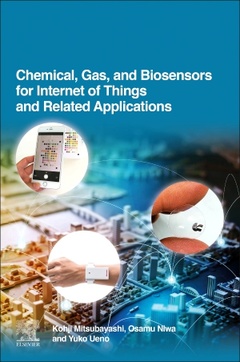Description
Chemical, Gas, and Biosensors for Internet of Things and Related Applications
Coordinators: Mitsubayashi Kohji, Niwa Osamu, Ueno Yuko
Language: English
Subjects for Chemical, Gas, and Biosensors for Internet of Things and...:
406 p. · 15x22.8 cm · Paperback
Description
/li>Contents
/li>Readership
/li>Biography
/li>Comment
/li>
Chemical, Gas, and Biosensors for the Internet of Things and Related Applications brings together the fields of sensors and analytical chemistry, devices and machines, and network and information technology. This thorough resource enables researchers to effectively collaborate to advance this rapidly expanding, interdisciplinary area of study. As innovative developments in the Internet of Things (IoT) continue to open new possibilities for quality of life improvement, sensor technology must keep pace, Drs. Mitsubayashi, Niwa and Ueno have brought together the top minds in their respective fields to provide the latest information on the numerous uses of this technology.
Topics covered include life-assist systems, network monitoring with portable environmental sensors, wireless livestock health monitoring, point-of-care health monitoring, organic electronics and bio-batteries, and more.
Part 1: Sensors and devices for internet of things Applications 1. Biochemical gas sensor (biosniffer) 2. Affinity and immune sensors 3. Enzyme-based sensors 4. Paper based sensors 5. Biochip sensors 6. Sensors for clinical applications 7. Surface acoustic wave (SAW) device gas sensors 8. MEMS biosensors for IoT
Part 2: Flexible, wearable, and mobile sensors and related technologies 9. Organic Electronics and bio-batteries 10. Wearable and implantable biosensors 11. Sensors for Point-of-Care Applications 12. Mobile exhaled-gas sensor 13. On-site environmental microorganism/microbial sensors
Part 3: Information and network technologies for sensor- internet of things applications 14. Life-assist system by sensor IoT 15. Network monitoring system by using portable environmental sensors 16. livestock health monitoring by using wireless network 17. Big data analysis of field monitoring sensors for agricultural applications
Primary: Academic researchers in universities and national laboratories studying chemistry and/or communication and healthcare; R&D engineers in companies in health, environment, safety, biomedicine, biotechnology, nanotechnology
Secondary: Managers of manufacturers and marketing research companies; law enforcement agencies and government officers; students
Osamu Niwa received his Ph.D. from the Department of Applied Chemistry, Kyushu University in 1990. He joined NTT Corporation in 1983. He was a Group Leader at NTT Lifestyle and Environmental Technology Laboratories from 1999 to 2004 and a Group Leader in National Institute of Advanced Industrial Science and Technology (AIST) from 2004 to 2015. His research interests include new nanocarbon films for biosensing and electroanalytical applications, surface Plasmon resonance-based devices and systems for immunosensing, and microfluidic devices for biomedical and clinical applications. He is the author of over 230 research articles published in international journals.
Yuko Ueno received her B.S., M.S., and Ph.D. in chemistry from The University of Tokyo in 1995, 1997, and 2002, respectively. She joined NTT Corporation in 1997. She was a post-doctoral fellow at the University of California at Berkeley and at Lawrence Berkeley National Laboratory, Berkeley, CA, USA, from 2004 to 2005. Her research interests are control of a biomolecular interface on a solid surface and its applications in biosensing.
- 2020 PROSE Awards - Winner: Category: Chemistry and Physics: Association of American Publishers
- Describes the latest advances and underlying principles of sensors used in biomedicine, healthcare, biotechnology, nanotechnology and food and environment safety
- Focuses on sensors’ methods of data communication, logging and analysis for IoT applications
- Explains the specific requirements of sensor design and performance improvement, helping researchers enhance sensitivity, selectivity, stability, reproducibility and response time

